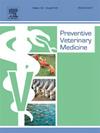通过系统的文献综述研究貘的疾病动态和死亡风险:对预防医学和保护的启示。
IF 2.2
2区 农林科学
Q1 VETERINARY SCIENCES
引用次数: 0
摘要
疾病对貘死亡率的影响以及对预防医学和保护的潜在影响尚不清楚。使用七个数据库和灰色文献进行了系统的文献综述,以解决这些空白。采用PRISMA语句报告结果,采用boosting回归树模型进行数据分析。筛选5323条记录并去除重复后,评估2484条记录的标题和摘要。在502项符合条件的研究中,只有206项符合所有纳入标准。这些研究在1924年至2023年间以10种语言发表,主要包括病例报告(45.1% %)和横断面研究(41.3% %)。72.9% %的报告发现感染性疾病,27.2% %的报告出现临床症状。受影响最大的系统是胃肠道(22.7% %)、肠系膜(22.1% %)和呼吸道(17.5% %)。呼吸系统疾病与死亡率增加有关。影响貘死亡率的因素包括物种(相对影响41.5 %)、地理位置(相对影响23.5 %)和圈养(相对影响16.8 %)。临床症状是最不重要的变量(4 %)。虽然传染性疾病与较高的死亡风险相关,但貘更有可能因非传染性疾病而患病,而不是传染性疾病。圈养的个体也比它们的野生同伴更容易生病。当考虑外部原因时,车辆碰撞是最重要的死亡原因(52.2% %),其次是狩猎(38.2% %)。疾病(8.7% %)是第三大原因,细菌感染是主要死亡原因。这篇综述代表了迄今为止对貘健康最全面的概述,并提供了整理来自不同研究设计的流行病学数据的新方法。本文章由计算机程序翻译,如有差异,请以英文原文为准。
Disease dynamics and mortality risk in tapirs (Perissodactyla: Tapiridae) through a systematic literature review: Implications for preventive medicine and conservation.
The impact of diseases on tapir mortality and potential implications for preventive medicine and conservation remain unclear. A systematic literature review was conducted using seven databases and grey literature to address these gaps. The PRISMA statement was adopted to report results, and boosted regression tree models were employed for data analysis. After screening 5323 records and removing duplicates, the title and abstract of 2484 records were assessed. Out of 502 eligible studies, only 206 met all inclusion criteria. These were published between 1924 and 2023 in ten languages, comprising mainly case reports (45.1 %) and cross-sectional studies (41.3 %). Infectious diseases were found in 72.9 % of the reports, and 27.2 % presented clinical signs. The most affected systems were gastroenteric (22.7 %), integumentary (22.1 %), and respiratory (17.5 %). Respiratory diseases were associated with increased mortality. Factors affecting tapir mortality included species (relative influence 41.5 %), followed by geographic location (23.5 %) and captivity (16.8 %). Clinical signs were the least important variable (4 %). While infectious diseases were associated with higher mortality risk, tapirs were more likely to become ill from non-infectious than infectious diseases. Captive individuals were also more likely to present with illness than their wild counterparts. When considering external causes, vehicle collisions represented the most significant cause of death (52.2 %), followed by hunting (38.2 %). Diseases (8.7 %) were the third most important, with bacterial infections the leading cause of death. This review represents the most comprehensive overview on tapir health to date and provides novel ways to collate epidemiological data from disparate study designs.
求助全文
通过发布文献求助,成功后即可免费获取论文全文。
去求助
来源期刊

Preventive veterinary medicine
农林科学-兽医学
CiteScore
5.60
自引率
7.70%
发文量
184
审稿时长
3 months
期刊介绍:
Preventive Veterinary Medicine is one of the leading international resources for scientific reports on animal health programs and preventive veterinary medicine. The journal follows the guidelines for standardizing and strengthening the reporting of biomedical research which are available from the CONSORT, MOOSE, PRISMA, REFLECT, STARD, and STROBE statements. The journal focuses on:
Epidemiology of health events relevant to domestic and wild animals;
Economic impacts of epidemic and endemic animal and zoonotic diseases;
Latest methods and approaches in veterinary epidemiology;
Disease and infection control or eradication measures;
The "One Health" concept and the relationships between veterinary medicine, human health, animal-production systems, and the environment;
Development of new techniques in surveillance systems and diagnosis;
Evaluation and control of diseases in animal populations.
 求助内容:
求助内容: 应助结果提醒方式:
应助结果提醒方式:


